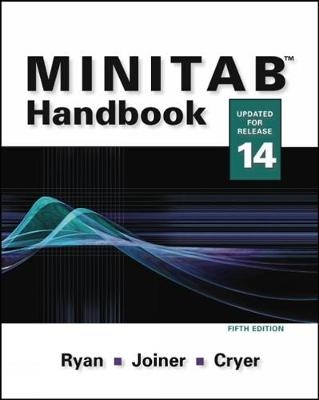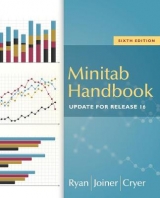
MINITAB® Handbook
Brooks/Cole (Verlag)
978-0-534-49600-5 (ISBN)
- Titel erscheint in neuer Auflage
- Artikel merken
1. INTRODUCTION TO MINITAB.
Welcome to MINITAB. Working with Data. Working with MINITAB Windows. Working with MINITAB Projects. The Project Manager. Exercises.
2. SESSION COMMANDS.
Enabling the MINITAB Command Language. Useful Session Commands. Working with the Contents of the Session Window. Exercises.
3. WORKSHEET OPERATIONS.
Editing the Worksheet. Manipulating Data. Importing and Exporting Data. Exercises.
4. ONE-VARIABLE GRAPHS AND SUMMARIES.
Understanding Variable Types. Exploring Graphs in MINITAB. Creating Distribution Plots. Histograms. Descriptive Statistics. Creating a Boxplot. Summarizing and Displaying Categorical Data. Exercises.
5. TWO- AND THREE-VARIABLE GRAPHS.
Creating Scatterplots. Creating Plots with Groups. Creating Plots with Several Variables. Graph Editing and Annotation. Graphs with Three or More Variables. Creating Time Series Plots. Exercises.
6. STATISTICAL DISTRIBUTIONS.
The Normal Distribution. The Binomial Distribution. Normal Approximation to the Binomial. The Poisson Distribution. A Summary of the Theoretical Distributions in MINITAB. Exercises.
7. SIMULATION.
Learning About Randomness. Bernoulli Trials. Simulating Data from a Normal Distribution. Simulating Data from the Binomial Distribution. Simulating Data from Other Distributions. Sampling Actual Populations. The Base for the Random Number Generator. The Central Limit Theorem. Exercises.
8. ONE-SAMPLE CONFIDENCE INTERVALS AND TESTS FOR MEANS.
How Sample Means Vary. Confidence Intervals for µ. Test of Hypothesis for µ. Confidence Intervals and Tests for Proportions. Departures from Assumptions. Exercises.
9. COMPARING TWO MEANS: CONFIDENCE INTERVALS AND TESTS.
Paired and Independent Data. Difference between Two Means: Paired Data. Difference Between Two Means: Independent Samples. Exercises.
10. ANALYSIS OF VARIANCE.
Analysis of Variance with One Factor. Analysis of Variance with Two Factors. Randomized Block Designs. Residuals and Fitted Values. Exercises.
11. REGRESSION AND CORRELATION.
Correlation. Simple Regression: Fitting a Straight Line. Making Inferences from Straight-Line Fits. Multiple Regression. Fitting Polynomials. Interpreting Residuals in Simple and Polynomial Regression. Using Transformations. Plotting Regressions Lines and Planes. Exercises.
12. CHI-SQUARE TESTS AND CONTINGENCY TABLES.
Chi-Square Goodness-of-Fit Test. Contingency Tables. Making the Table and Computing Chi-Square. Tables with Small Expected Counts. Exercises.
13. NONPARAMETRIC STATISTICS.
Sign Procedures. Wilcoxon Signed Rank Procedures. Two-Sample Rank Procedures. Kruskal-Wallis Test. Exercises.
14. CONTROL CHARTS.
Control Charts and Process Variation. Control Charts for Measurement Data. Control Charts for Attribute Data. Exercises.
15. ADDITIONAL TOPICS IN REGRESSION.
Variable Selection in Regression. Diagnostics in Regression. Additional Regression Features. Exercises.
16. ADDITIONAL TOPICS IN ANALYSIS OF VARIANCE.
Multiple Comparisons with One-Way. Multifactor Balanced Designs. Unbalanced Designs. Analysis of Covariance. Random Effects and Mixed Models. Exercises.
17.CREATING A REPORT.
Adding Session Output to the ReportPad. Adding a Graph to the ReportPad. Editing in ReportPad. Saving a Report. Copying a Report to a Word Processor. Exercises.
18. MINITAB MACROS.
Global Macros. Writing a Macro. Invoking a Macro. Variable Column and Row Numbers. Control Statements. Available Macros. Exercises.
APPENDIX A: DATA SETS USED IN THIS HANDBOOK.
CREDITS.
INDEX.
| Verlagsort | CA |
|---|---|
| Sprache | englisch |
| Maße | 190 x 233 mm |
| Gewicht | 795 g |
| Themenwelt | Mathematik / Informatik ► Informatik ► Web / Internet |
| ISBN-10 | 0-534-49600-8 / 0534496008 |
| ISBN-13 | 978-0-534-49600-5 / 9780534496005 |
| Zustand | Neuware |
| Informationen gemäß Produktsicherheitsverordnung (GPSR) | |
| Haben Sie eine Frage zum Produkt? |
aus dem Bereich



